Hafez facts for kids
Quick facts for kids Hafez |
|
|---|---|
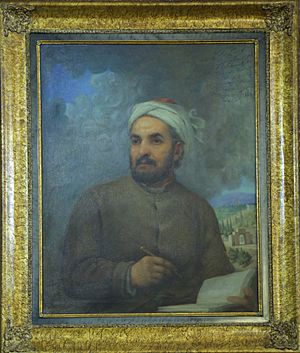
A painting of Hafez by Abolhassan Sadighi.
|
|
| Spiritual poet, mystic | |
| Born | circa. 1325 Shiraz, Muzaffarid Persia |
| Died | 1390 (aged 64–65) Shiraz, Timurid Empire (present-day Iran) |
| Major shrine | Tomb of Hafez, Shiraz, Iran |
| Influences | Ibn Arabi, Khwaju, Al-Hallaj, Sanai, Anvari, Nizami, Sa'di, Khaqani, Attar |
| Influenced | Subsequent Persian lyric poets, Goethe |
|
Tradition or genre
|
Mystic poetry (Ghazal, Irfan) |
| Major works | The Divān of Hafez |
Khwāje Shams-od-Dīn Moḥammad Ḥāfeẓ-e Shīrāzī (Persian: خواجه شمسالدین محمّد حافظ شیرازی), known by his pen name Hafez (حافظ, Ḥāfeẓ, 'the memorizer; the (safe) keeper'; 1325–1390) and as "Hafiz", was a Persian lyric poet, whose collected works are regarded by many Iranians as a pinnacle of Persian literature. His works are often found in the homes of people in the Persian-speaking world, who learn his poems by heart and use them as everyday proverbs and sayings. His life and poems have become the subjects of much analysis, commentary and interpretation, influencing post-14th century Persian writing more than any other Persian author.
Hafez is best known for his Divan of Hafez, a collection of his surviving poems probably compiled after his death. His works can be described as "antinomian" and with the medieval use of the term "theosophical"; the term "theosophy" in the 13th and 14th centuries was used to indicate mystical work by "authors only inspired by the holy books" (as distinguished from theology). Hafez primarily wrote in the literary genre of lyric poetry or ghazals, that is the ideal style for expressing the ecstasy of divine inspiration in the mystical form of love poems. He was a Sufi.
Themes of his ghazals include the beloved, faith and exposing hypocrisy. In his ghazals he deals with love, wine and taverns, all presenting ecstasy and freedom from restraint, whether in actual worldly release or in the voice of the lover speaking of divine love. His influence on Persian speakers appears in divination by his poems (Persian: فال حافظ, fāl-e hāfez, somewhat similar to the Roman tradition of sortes vergilianae) and in the frequent use of his poems in Persian traditional music, visual art and Persian calligraphy. His tomb is located in his birthplace of Shiraz. Adaptations, imitations and translations of his poems exist in all major languages.
Contents
Life
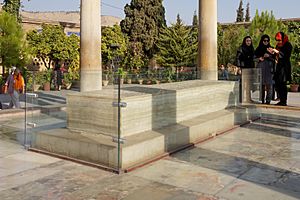
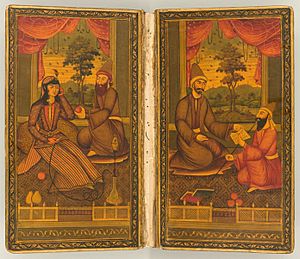
Hafez was born in Shiraz, Iran. Few details of his life are known. Accounts of his early life rely upon traditional anecdotes. Early tazkiras (biographical sketches) mentioning Hafez are generally considered unreliable. At an early age, he memorized the Quran and was given the title of Hafez, which he later used as his pen name. The preface of his Divān, in which his early life is discussed, was written by an unknown contemporary whose name may have been Moḥammad Golandām. Two of the most highly regarded modern editions of Hafez's Divān are compiled by Moḥammad Ghazvini and Qāsem Ḡani (495 ghazals) and by Parviz Natel-Khanlari (486 ghazals). Hafez was a Sufi Muslim.
Modern scholars generally agree that he was born either in 1315 or 1317. According to an account by Jami, Hafez died in 1390. Hafez was supported by patronage from several successive local regimes: Shah Abu Ishaq, who came to power while Hafez was in his teens; Timur at the end of his life; and even the strict ruler Shah Mubariz ud-Din Muhammad (Mubariz Muzaffar). Though his work flourished most under the 27-year rule of Jalal ud-Din Shah Shuja (Shah Shuja), it is claimed Hāfez briefly fell out of favor with Shah Shuja for mocking inferior poets (Shah Shuja wrote poetry himself and may have taken the comments personally), forcing Hāfez to flee from Shiraz to Isfahan and Yazd, but no historical evidence is available. Hafez also exchanged letters and poetry with Ghiyasuddin Azam Shah, the Sultan of Bengal, who invited him to Sonargaon though he could not make it.
Twenty years after his death, a tomb, the Hafezieh, was erected to honor Hafez in the Musalla Gardens in Shiraz. The current mausoleum was designed by André Godard, a French archeologist and architect, in the late 1930s, and the tomb is raised up on a dais amidst rose gardens, water channels, and orange trees. Inside, Hafez's alabaster sarcophagus bears the inscription of two of his poems.
Legends
Many semi-miraculous mythical tales were woven around Hafez after his death. It is said that by listening to his father's recitations, Hafez had accomplished the task of learning the Quran by heart at an early age (that is the meaning of the word Hafez). At the same time, he is said to have known by heart the works of Rumi (Jalal ad-Din Muhammad Balkhi), Saadi, Farid ud-Din, and Nizami.
According to one tradition, before meeting his self-chosen Sufi master Hajji Zayn al-Attar, Hafez had been working in a bakery, delivering bread to a wealthy quarter of the town. There, he first saw Shakh-e Nabat, a woman of great beauty, to whom some of his poems are addressed. Ravished by her beauty but knowing that his love for her would not be requited, he allegedly held his first mystic vigil in his desire to realize this union. Still, he encountered a being of surpassing beauty who identified himself as an angel, and his further attempts at union became mystic; a pursuit of spiritual union with the divine.
At 60, he is said to have begun a Chilla-nashini, a 40-day-and-night vigil by sitting in a circle that he had drawn for himself. On the 40th day, he once again met with Zayn al-Attar on what is known to be their fortieth anniversary and was offered a cup of wine. It was there where he is said to have attained "Cosmic Consciousness". He hints at this episode in one of his verses in which he advises the reader to attain "clarity of wine" by letting it "sit for 40 days".
In one tale, Tamerlane (Timur) angrily summoned Hafez to account for one of his verses:
|
'agar 'ān Tork-e Šīrāzī * be dast ārad del-ē mā-rā |
If that Shirazi Turk accepts my heart in their hand, |
Samarkand was Tamerlane's capital and Bokhara was the kingdom's finest city. "With the blows of my lustrous sword", Timur complained, "I have subjugated most of the habitable globe... to embellish Samarkand and Bokhara, the seats of my government; and you would sell them for the black mole of some girl in Shiraz!"
Hafez, the tale goes, bowed deeply and replied, "Alas, O Prince, it is this prodigality which is the cause of the misery in which you find me". So surprised and pleased was Timur with this response that he dismissed Hafez with handsome gifts.
Influence
Intellectual and artistic legacy
Hafez was acclaimed throughout the Islamic world during his lifetime, with other Persian poets imitating his work, and offers of patronage from Baghdad to India.
His work was first translated into English in 1771 by William Jones. It would leave a mark on such Western writers as Thoreau, Goethe, W. B. Yeats, in his prose anthology book of essays, Discoveries, as well as gaining a positive reception within West Bengal, in India, among some of the most prolific religious leaders and poets in this province, Debendranath Tagore, Rabindranath Tagore's father, who knew Persian and used to recite from Hafez's Divans and in this line, Gurudev himself, who, during his visit to Persia in 1932, also made a homage visit to Hafez's tomb in Shiraz and Ralph Waldo Emerson (the last referred to him as "a poet's poet"). Sir Arthur Conan Doyle has his character Sherlock Holmes state that "there is as much sense in Hafiz as in Horace, and as much knowledge of the world" (in A Case of Identity). Friedrich Engels mentioned him in an 1853 letter to Karl Marx.
There is no definitive version of his collected works (or Dīvān); editions vary from 573 to 994 poems. Only since the 1940s has a sustained scholarly attempt (by Mas'ud Farzad, Qasim Ghani and others in Iran) been made to authenticate his work and to remove errors introduced by later copyists and censors. However, the reliability of such work has been questioned, and in the words of Hāfez scholar Iraj Bashiri, "there remains little hope from there (i.e.: Iran) for an authenticated diwan".
In contemporary Iranian culture
Hafez is the most popular poet in Iran, and his works can be found in almost every Iranian home. In fact, October 12 is celebrated as Hafez Day in Iran.
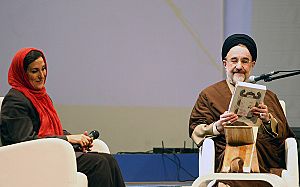
His tomb is "crowded with devotees" who visit the site and the atmosphere is "festive" with visitors singing and reciting their favorite Hafez poems.
Many Iranians use Divan of Hafez for fortune telling. Iranian families usually have a Divan of Hafez in their house, and when they get together during the Nowruz or Yaldā holidays, they open the Divan to a random page and read the poem on it, which they believe to be an indication of things that will happen in the future.
In Iranian music
In the genre of Persian classical music Hafez along with Sa'di have been the most popular poets in the art of āvāz, non-metered form of singing. Also the form 'Sāqi-Nāmeh' in the radif of Persian music is based on the same title by Hafez. A number of contemporary composers such as Parviz Meshkatian (Sheydaie), Hossein Alizadeh (Ahu-ye Vahshi), Mohammad Reza Lotfi (Golestān), and Siamak Aghaie (Yād Bād) have composed metric songs (tasnif) based on ghazals of Hafez which have become very popular in the genre of classical music. Hayedeh performed the song "Padeshah-e Khooban", with music by Farid Zoland. The Ottoman composer Buhurizade Mustafa Itri composed his magnum opus Neva Kâr based upon one of Hafez's poems. The Polish composer Karol Szymanowski composed The Love Songs of Hafiz based upon a German translation of Hafez poems.
In Afghan music
Many Afghan singers, including Ahmad Zahir and Sarban, have composed songs such as "Ay Padeshah-e Khooban", "Gar-Zulfe Parayshanat".
Satire, religion, and politics
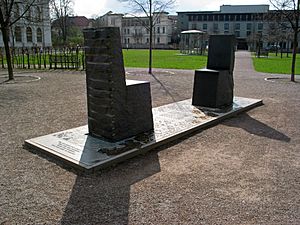
Though Hafez is well known for his poetry, he is less commonly recognized for his intellectual and political contributions. A defining feature of Hafez' poetry is its ironic tone and the theme of hypocrisy, widely believed to be a critique of the religious and ruling establishments of the time. Persian satire developed during the 14th century, within the courts of the Mongol Empire. In this period, Hafez and other notable early satirists, such as Ubayd Zakani, produced a body of work that has since become a template for the use of satire as a political device. Many of his critiques are believed to be targeted at the rule of Mubariz al-Din Muhammad, specifically, towards the disintegration of important public and private institutions.
His work, particularly his imaginative references to monasteries, convents, Shahneh, and muhtasib, ignored the religious taboos of his period, and he found humor in some of his society's religious doctrines. Employing humor polemically has since become a common practice in Iranian public discourse and satire is now perhaps the de facto language of Iranian social commentary.
Modern English editions
A standard modern English edition of Hafez is Faces of Love (2012) translated by Dick Davis for Penguin Classics. Beloved: 81 poems from Hafez (Bloodaxe Books, 2018) is a recent English selection noted by Fatemeh Keshavarz (Roshan Institute for Persian studies, University of Maryland) for preserving "that audacious and multilayered richness one finds in the originals".
Peter Avery translated a complete edition of Hafez in English, The Collected Lyrics of Hafiz of Shiraz, published in 2007. It was awarded Iran's Farabi prize. Avery's translations are published with notes explaining allusions in the text and filling in what the poets would have expected their readers to know. An abridged version exists, titled Hafiz of Shiraz: Thirty Poems: An Introduction to the Sufi Master.
Divan-e-Hafez
Divan Hafez is a book containing all the remaining poems of Hafez. Most of these poems are in Persian and the most crucial part of this Divan is ghazals. There are poems in other poetic formats such as piece, ode, Masnavi and quatrain in this Divan.
There is no evidence that most of Hafez's poems were destroyed. In addition, Hafez was very famous during his lifetime; Therefore, the small number of poetry in the court indicates that he was not a prolific poet.
Hafez's Divan was probably compiled for the first time by Mohammad Glendam after his death. Of course, some unconfirmed reports indicate that Hafez published his court in 770 AH. that is, edited more than twenty years before his death.
Death and the tomb
The year of Hafez's death is 791 AH. Hafez was buried in the prayer hall of Shiraz called hafezieh. In 855 AH, after the conquest of Shiraz by Abolghasem Babar Teymouri, they built a tomb under the command of his minister, Maulana Mohammad Mamaei.
Poems by Hafez
The number in the edition by Muhammad Qazvini and Qasem Ghani (1941) is given, as well as that of Parviz Nātel-Khānlari (2nd ed. 1983):
- Alā yā ayyoha-s-sāqī – QG 1; PNK 1
- Dūš dīdam ke malā'ek – QG 184; PNK 179
- Goftā borūn šodī – QG 406; PNK 398
- Mazra'-ē sabz-e falak – QG 407; PNK 399
- Naqdhā rā bovad āyā – QG 185; PNK 180
- Sālhā del talab-ē jām – QG 142 (Ganjoor 143); PNK 136
- Shirazi Turk – QG 3; PNK 3
- Sīne mālāmāl – QG 470; PNK 461
- Zolf-'āšofte – QG 26; PNK 22
See also
 In Spanish: Hafez de Shiraz para niños
In Spanish: Hafez de Shiraz para niños
- Diwan (poetry)
- List of Persian poets and authors
- Persian metres
- Persian mysticism
- Rumi, Persian poet
- Persian literature
- The Love Songs of Hafiz
- West-östlicher Diwan

